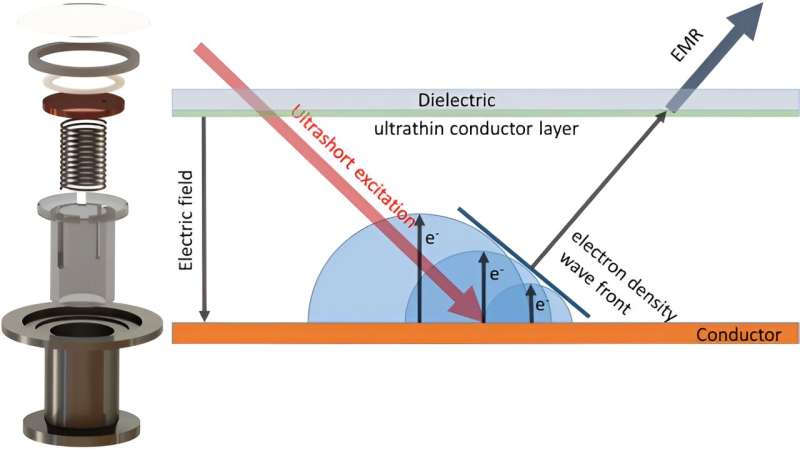

Credit: Frontiers of Optoelectronics (2024). DOI: 10.1007/s12200-024-00123-5
The propagation of charged particles in a medium at a speed that exceeds the phase speed of light in the medium (this speed is also called superluminal) leads to the generation of radiation. The radiation diagram generated during this process has a conical structure. This effect, called the Cherenkov effect, has many fundamental and applied applications, and its explanation was awarded the Nobel Prize in Physics in 1958.
Oblique incidence of light at the interface between two media is a similar phenomenon; in this case, a wave of secondary sources of radiation is formed along the interface, which propagates at a speed exceeding the phase speed of light.
The refraction and reflection of light from an interface is the result of the addition of the amplitudes of the waves from all the sources formed during the incidence of light. If we take into account the interface with the photo-emitting material – the cathode, on which the light falls obliquely and the causes of electron emission – then a wave of electron density will form along the surface of the cathode with superluminal speed.
This phenomenon is associated with the generation of secondary radiation. The application of an external electric field leads to the acceleration of electrons and, as a consequence, an increase in the energy of electrons and secondary radiation for such sources.
Researchers from the Prokhorov Institute of General Physics of the Russian Academy of Sciences have proposed using superluminal wave formation of electron emission sources to generate terahertz radiation. The study, titled “Pulsed THz radiation under ultrafast vacuum photodiode optical discharge,” is published in Frontiers of Optoelectronics.
The main idea is to apply ultrashort laser pulses to the surface of the cathode, which leads to the formation of an ultrashort electron beam. The electrons are then accelerated by an external field and suddenly stopped in a thin dielectric layer, which led to the generation of electromagnetic pulses in the microwave and terahertz range.
The authors propose scaling up such sources by increasing the efficiency of photo-emitting coatings. The results of this work open up new sources of THz radiation for tasks in broadband noninvasive tomography, imaging, radar, and energy effects in electronics.
More information:
Aleksandr Ushakov et al, Pulsed THz radiation under ultrafast vacuum photodiode optical discharge, Frontiers of Optoelectronics (2024). DOI: 10.1007/s12200-024-00123-5
Provided by Frontiers Journals
citation: When ultrashort electron bunch accelerates and stops drastically, it can generate terahertz radiation (2024, July 1) Retrieved July 2, 2024 from https://phys.org/news/2024-07-ultrashort-electron-bunch -drastically-generate. html
This document is subject to copyright. Except for any fair agreement for study or private research purposes, no part may be reproduced without written permission. The content is provided for informational purposes only.
#ultrashort #electron #beam #accelerated #stopped #drastically #generate #terahertz #radiation
Image Source : phys.org

Leave a Reply